Speech Global And Domestic Influences on the Australian Bond Market

Guy Debelle[*]
Assistant Governor (Financial Markets)
KangaNews Debt Capital Markets Summit 2015
Sydney –
- Audio 14.43MB
- Q&A Transcript
Today I will talk about some of the global and domestic factors that are influencing conditions in the Australian bond market. I'll start with a discussion on the decline in global bond yields that we've seen over the past year or so before turning to focus on how these and other developments have played out in the Australian bond market. I will finish with some recent and prospective regulatory developments affecting the local market.
Global Influences
At the beginning of 2014, the 10-year Treasury yield in the US was around 3 per cent. At that yield, investors were getting some compensation for duration risk in the form of a term premium; that is, some compensation for uncertainty about the future path of US monetary policy. However, over the course of 2014 the yield declined steadily, reaching a low of 1.64 per cent in early 2015, close to the historical lows reached in July 2012. With a yield of 1.64, investors were getting little or no compensation for term risk or the risk of inflation. Indeed, one could argue that the term premium was even negative. There was no meaningful compensation for uncertainty about the path of US monetary policy or inflation.
This decline in US yields was also evident in nearly all advanced economies and occurred despite some notable variations across countries at the shorter end of the curve (Graph 1). Over recent months, it has looked more like yields in Germany driving those in the US and elsewhere rather than the traditional relationship of US yields driving those in other markets.
In recent weeks, some of the decline in yields has been unwound in the US and a few other economies such as the UK, but 10-year yields in the euro area have fallen further to reach new historic lows, with the 10-year yield in Germany now noticeably below that in Japan. As has been remarked on frequently, the 10-year yields in Spain and Ireland are currently below that in the US.
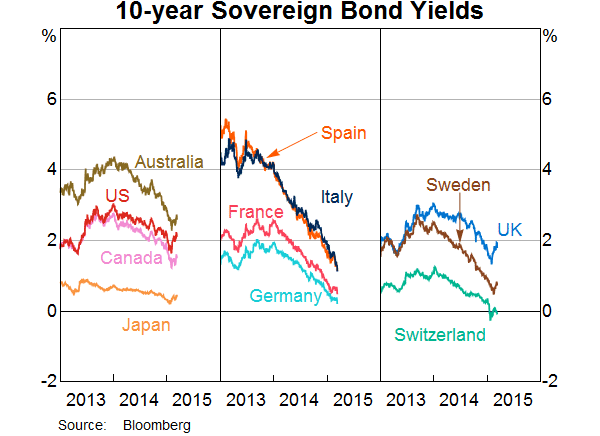
At the shorter end of the yield curve, expectations for future monetary policy settings are an important driver. There has been a notable divergence in expectations for the path of monetary policy in major developed economies since the middle of 2013. In the US, the Fed gradually slowed the pace of its asset purchases from January 2014 and ceased them altogether in October. More recently, it has indicated that it is getting closer to raising the level of the federal funds rate target for the first time in nearly a decade.
In contrast, over the same period the European Central Bank (ECB) has moved to further loosen monetary policy settings in the euro area, culminating with the announcement in early 2015 of a sovereign bond purchase program. Several European countries that are not members of the euro area have lowered the interest rate paid on deposits with the central bank to negative territory, a move that the ECB made in September 2014. Meanwhile, the Bank of Japan (BoJ) has continued its quantitative easing program, increasing the scale of its asset purchases in late October.
The influence of this divergence in monetary policy on the relevant sovereign bond markets is evident in the movements in yields on 2-year government bonds over the past 18 months (Graph 2). In particular, 2-year US Treasury yields have risen a little since late 2013 while 2-year German government bond yields have declined steadily and turned negative.
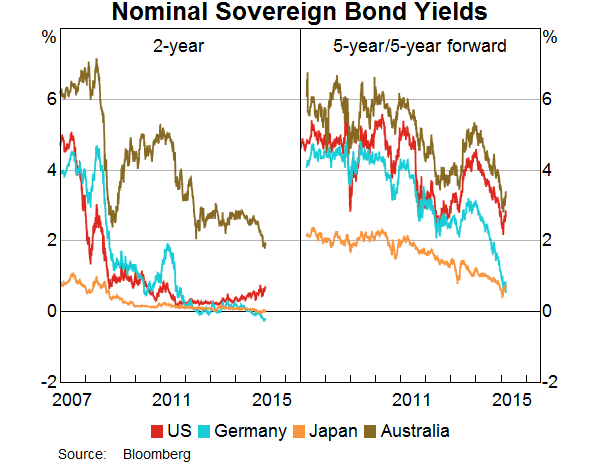
At the longer end of the curve, as I noted earlier, the trajectory of sovereign yields has been more uniform, with the implied yield on a 5-year bond starting in 5 years' time (the 5-year, 5-year-forward yield) falling consistently throughout 2014. The uniformity of these movements suggests that global factors have played a role. While it is straightforward to come up with explanations for the direction of movement in yields, I do not find any of them compelling in explaining the size of the downward movement.
One possible contributor to the decline in yields has been concerns about the global growth outlook, but expectations for global growth over the medium term haven't changed all that much. Secular stagnation is also another popular explanation as lower real growth implies lower real yields (although I am more optimistic about the world than the one this theory implies). Yields may also have been influenced by the prospective reduced supply of government bonds: the gradual improvement in governments' fiscal positions is reducing funding needs and government bond issuance. At the same time, the quantitative easing programs of the ECB and the BoJ have also worked to increase actual and anticipated demand for bonds, and there is increased demand from banks to hold sovereign debt to meet liquidity requirements. While the Fed is no longer making net purchases, it has indicated that it will keep the stock of its asset holdings constant for some time by reinvesting maturing holdings in US Treasuries.
One remarkable outcome is that a large proportion of developed countries' government bonds are now trading at negative yields in secondary markets. Two-thirds of the German and Swiss government bonds on issue are currently trading at negative yields, while yields on bonds of up to five years in maturity from the Japanese and a variety of European governments have recently traded at negative yields.
Five-year, 5-year-forward real yields have generally followed the trajectory of nominal yields, but have declined by less over 2014. With larger declines in nominal yields than real yields, estimated breakeven inflation rates – the spread between nominal and inflation-linked bond yields – have declined (Graph 3). (This calculation is complicated somewhat by the relatively lower liquidity in indexed bond markets.)
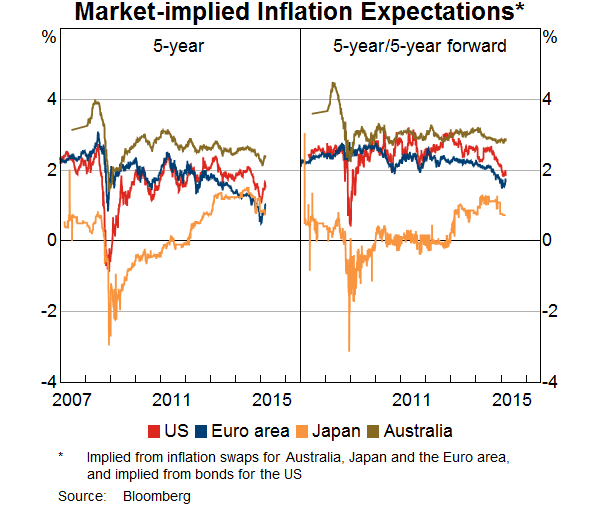
One interpretation of this is that expectations for inflation have fallen considerably. The sharp decline in oil prices has certainly reduced near-term inflation expectations as most advanced economies are net oil importers. But this would only account for a decline in inflation expectations in the short term. A substantial decline in medium-term inflation expectations is more difficult to explain. Survey-based inflation expectations from market economists and consumers do not appear to have declined substantially over the same period. It is also worth noting that the decline in longer-run inflation expectations over the past six months is not a universal phenomenon – Australian breakeven rates were broadly flat over the second half of 2014 (and consistent with the RBA's inflation target).
Finally, one potential explanation that I have only briefly discussed above is that yields are being held down by a shortage of risk-free assets as demand for these assets has increased.[1] I find this explanation of increased demand for such assets in the face of slower growth in the supply to be the most plausible. But even so, term premia are unusually compressed and there is little overall compensation for risk.
Australian Government Bond Market
Yields on Australian Government bonds have been affected by these international factors over recent months as well as some domestic influences. At the shorter end, the February reduction in the cash rate target and associated repricing of market expectations for future monetary policy have contributed to a decline in yields. At the longer end, there has been a tendency for yields to follow developments in global markets. While the strong historical correlation between yields on long-term Australian and US government bonds has been evident, the spread between 10-year yields has narrowed considerably, declining from 100 basis points in the middle of last year to be as low as 40 basis points. The net outcome of these developments has seen yields on Australian 10-year Commonwealth Government securities (CGS) decline to their lowest level since Federation with an all-time low of 2.28 per cent being recorded in February (Graph 4).
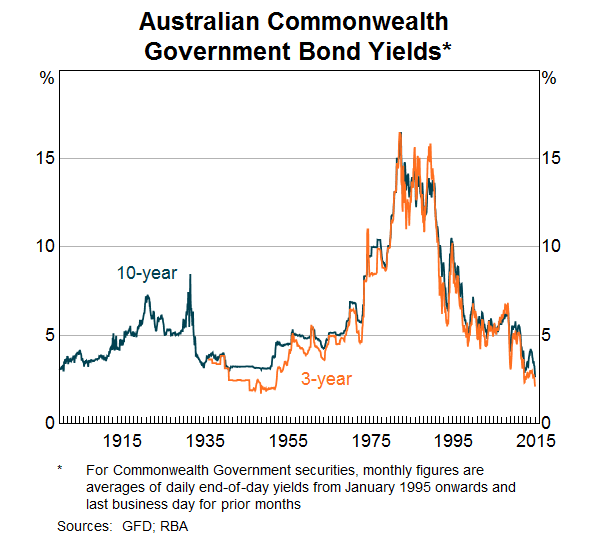
These declines in CGS yields over recent years – and similar declines in yields on state government bonds (‘semis’) – have occurred notwithstanding an increase in the supply of CGS and semis on issue. But the stock of debt on issue remains considerably less as a share of GDP than nearly all other jurisdictions (Graph 5).
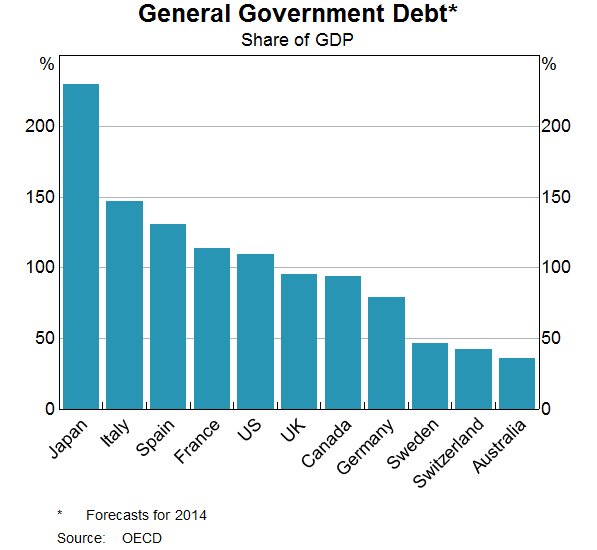
The vast majority of the post-crisis CGS issuance has been purchased by non-residents attracted to the Australian Government's AAA credit rating and favourable level of yields relative to other highly rated sovereign issuers. The six-fold increase in non-residents' holdings of CGS since late 2007 took non-residents' ownership of the outstanding stock of CGS to just under 80 per cent in 2010, although this share has declined a little recently (Graph 6). The recent decline is not because of any net selling, but rather because buying has not quite kept pace with recent issuance.
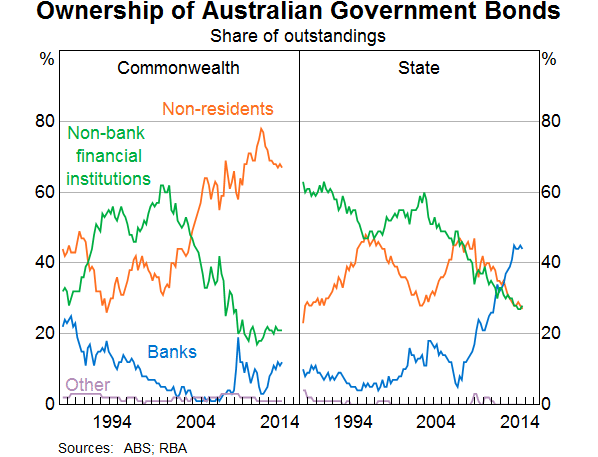
The increased foreign holdings of government debt have been reflected in a notable change in the composition of Australia's foreign liabilities (Graph 7). The stock of net foreign liabilities has remained steady at around 55 per cent of GDP for the past decade. But over the past five years, foreign holdings of Australian government debt have risen to around 20 per cent of GDP, with a broadly offsetting decline in foreign holdings of Australian bank debt as a share of GDP.
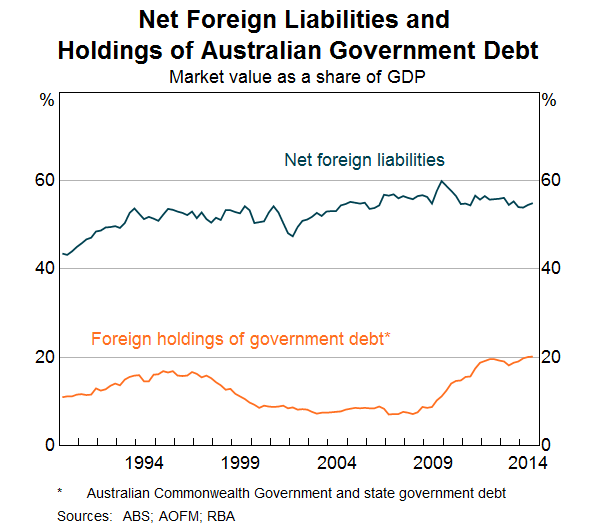
Turning to developments in the semis market, yields on semis have fallen by more than those on CGS, such that secondary market spreads have fallen to around 30 basis points. This is around the lowest spread seen since the early 2000s and semi yields are at historical lows. State governments are able to borrow on average at rates under 3 per cent (Graph 8). In terms of ownership, since 2007 there has been a marked increase in the share held by banks in Australia. This is a consequence of banks' desire to hold more high-quality liquid assets (HQLA) in the aftermath of the global financial crisis and, more recently, the Liquidity Coverage Ratio (LCR) prudential requirements that came into effect in Australia at the beginning of 2015.
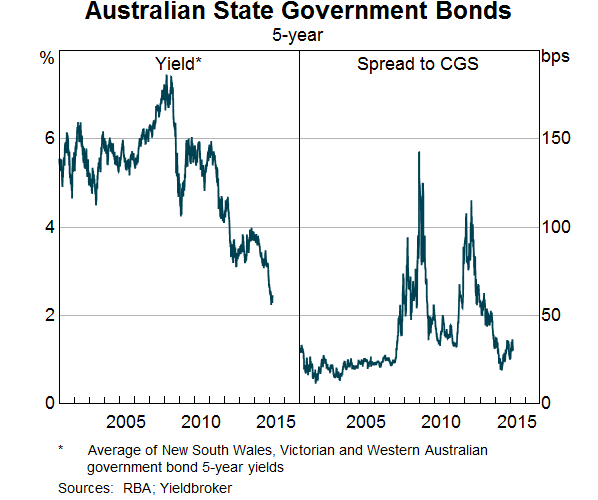
APRA has determined that the Australian banking system needs to hold around $410 billion of HQLA in 2015. Of this amount, and based on RBA advice, up to $175 billion could be met through holding CGS and semis. The Bank's assessment is that larger holdings by Australian banks could impair liquidity of these securities, undermining the purpose of the LCR. The introduction of the LCR has proceeded smoothly, but of course APRA and the RBA will continue to monitor developments in markets to ensure that liquidity conditions remain appropriate.
The increased demand from banks for semis is having a noticeable impact on the type of debt securities being issued by the states (Graph 9). In line with the banks' preference for floating-rate debt – which can be better matched to banks' floating-rate liabilities – the share of floating-rate semis in recent years has increased. Consequently, the share of floating-rate notes in the outstanding stock of semis has increased from 2 per cent at the end of 2012 to around 10 per cent at present. Similarly, the preference of banks for shorter term debt has led to a decline in the average tenor of semis outstanding.
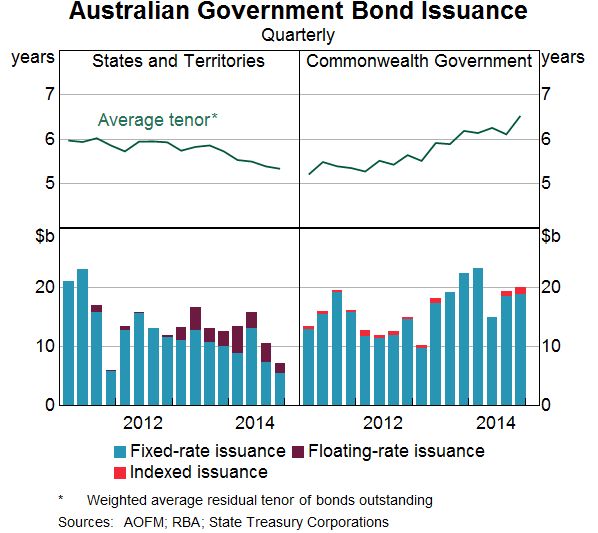
Regulatory Developments
I will finish by discussing the effect of some recent regulatory changes in the local fixed income market.
One global development that has garnered a large amount of comment of late is the effect of reduced market-making capacity in fixed income.[2] The Bank for International Settlements (BIS) Committee on the Global Financial System (CGFS), of which I am a member, issued a report on this topic late last year.[3] That report documents the intended effect of regulation in bringing about this reduction. There is a debate as to whether the reduction has gone too far, but the fact that market-making activity is lower than it was pre-crisis is a desirable outcome given liquidity risk was under-priced pre-crisis.
Rather than describing it as a reduction in market-making, I think it is more useful to think of it as a reduction in the risk-absorption capacity of intermediaries. Their ability to warehouse portfolio adjustments of asset managers is curtailed. In the past, asset managers were dealing bilaterally with individual trading desks that each had their own limit. Now these limits are applied holistically across the trading desks so that selling one part of a portfolio to one desk will reduce the capacity to sell another part of the portfolio to another desk in the same institution. Asset managers need to take account of these changes in market dynamics in thinking about how they adjust their portfolios. Transactions costs are higher and, in particular, liquidity costs are higher. I am not sure that all market participants have fully appreciated this yet and are fully cognisant of the impact of the post-crisis changes.
The second development to note is in the asset-backed security space. As many of you know, as of 30 June this year, the Bank will introduce mandatory reporting requirements for repo-eligible asset-backed securities (ABS). The Bank continues to work with the industry to ensure the timely implementation of these requirements. The required information, which must also be made available to permitted users, will promote greater transparency in the market, supporting investor confidence in these assets. These requirements will also provide the Bank with standardised and detailed data on ABS, which are a major part of the collateral eligible to be used under the CLF.
In preparation for the introduction of these reporting requirements and to facilitate industry readiness, the reporting system for securitisations was made available for industry testing in November 2014, with voluntary reporting accepted from 31 December 2014. The Bank is currently working with a number of institutions undertaking test submissions, with some institutions expecting to commence regular reporting shortly. The industry is strongly encouraged to undertake testing early to ensure readiness for the commencement of mandatory reporting on 30 June 2015.
The third development is the proposed changes to the settlement convention to T+2 for over-the-counter (OTC) transactions in domestic fixed income securities. The Bank strongly encouraged this initiative. The current standard of T+3 settlement in the Australian market compares unfavourably with many other jurisdictions that have already progressed to shorter settlement cycles for OTC transactions in their domestic fixed income markets. A shorter settlement cycle will reduce the risks associated with settlement, in particular, counterparty risk. Market makers in OTC fixed income securities may particularly benefit from the reduced period of counterparty exposure, as any given trade will count towards internal credit limits for a shorter period of time. This could boost market turnover and trading capacity for participants. Further, moving to T+2 is likely to encourage straight-through processing, which could reduce the risk of an operational issue affecting the settlement of OTC fixed income securities. Ideally, this would be implemented by the end of 2015.
Finally, a few words on interest rate benchmarks. The RBA, together with ASIC, is working with the industry through AFMA to develop a robust risk-free interest rate benchmark in the local market, likely based on overnight indexed swap (OIS) rates. Once this is operational, this will help engender a movement of products towards referencing a risk-free benchmark rather than a credit benchmark such as bank bill swap (BBSW) rates.[4] We expect to see progress on this in the coming months.
Conclusion
To conclude, there are a large number of moving parts in fixed income at the moment. A number of international and domestic factors are having an important influence on Australian bond markets. The low levels of yields globally and domestically are difficult to explain, most notably the low level of term premia. The most plausible explanation relates to a shortage of ‘risk-free’ assets although with term premia so low, it's not clear how risk-free they actually are.
At the same time as grappling with these developments, investors need to be aware of the changed market dynamics and factor the higher transactions costs in fixed income, and particularly the higher cost of liquidity provision, into their decision-making.
Endnotes
I would like to thank Emma Doherty, Suchita Mathur and John Boulter for their assistance in preparing these remarks. [*]
Zoltan Pozsar has some interesting work on this; see Pozsar Z (2015), ‘A Macro View of Shadow Banking: Levered Betas and Wholesale Funding in the Context of Secular Stagnation’, mimeo, 31 January, available at <http://ineteconomics.org/sites/inet.civicactions.net/files/Macro_View_Final.XcxMB4_.pdf>. Ricardo Caballero has also written on this topic; see Caballero R (2013), ‘The Shortage of Safe Assets: Macroeconomic Policy Implications’, presentation at the Bank of England, May, available at <http://www.bankofengland.co.uk/research/Documents/ccbs/cew2013/presentation_caballero.pdf>. [1]
Debelle G (2014), ‘Volatility and Market Pricing’, Speech to Citi's 6th Annual Australian and New Zealand Investment Conference, Sydney, 14 October. [2]
CGFS (2014), ‘Market-making and Proprietary Trading: Industry Trends, Drivers and Policy Implications’, CGFS Papers No 52. Available at <http://www.bis.org/publ/cgfs52.htm>. Jon Cheshire, who was a member of the working group, has an article in the March RBA Bulletin discussing this issue from an Australian perspective. [3]
This is part of a global initiative that is part of the FSB work agenda. [4]